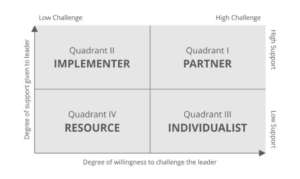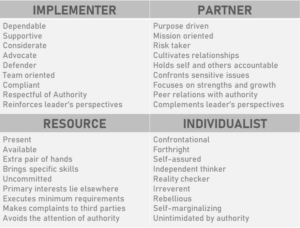In Your Power: React Less, Regain Control, Raise Others
Sharon Melnick, PhD., the leading expert on guiding leaders to be in their power and author of a best-selling new book In Your Power: React Less, Regain Control, Raise Others, shares this article as a companion to her podcast In Your Power.
Listen to the companion interview and past episodes of Innovating Leadership, Co-Creating Our Future via Apple Podcasts, TuneIn, Stitcher, Spotify, Amazon Music, Audible, iHeartRADIO, and NPR One.
Facing overwhelmed calendars, ‘quiet quitting’ team members, and competing agendas with colleagues, many leaders can feel like their day is a battle to be heard, accomplish important work, and feel valued.
When this is the case, the leader’s experience is like a ‘thermometer’ – their mental and emotional state goes up and down according to circumstances and other people’s actions. Being the thermometer makes you feel powerless, causing burnout or resignation.
Leaders always have more power than they think they do, and can access this power by shifting from being the thermometer to being the ‘thermostat’. When you are the thermostat, you set the tone, you have a vision and bring people along toward it.
The word power comes from the Latin root posse, which means “to be able”.
Being in your power is the ability to ‘stay good in you’ and then to make it better for everyone around you.
Being in your power transforms your leadership from reactive to transformational.
Here are 3 mistakes that keep a leader from being in their power and using their power as a force for good:
1. You leak your power.
As humans, we are biologically wired to focus on what we can’t control so we can track threats and respond to them promptly. When we act from this factory setting, it keeps you as the thermometer.
For example, Keisha was a leader in a finance function which had a lot of holes in its system. Her SVP and business partners would reach out to her from 7am to 11pm. She was overwhelmed and spent her days ‘fighting fires’. She got to the point where she was ready to leave.
Where was her power? We sorted out the aspects of the situation she could control, her 50%, and distinguished those from the aspects of the situation she couldn’t control, the other 50%. She became impeccable for her 50%, maximizing what she could control.
She started to approach the situation as the thermostat: she gathered the involved parties into a series of meetings, presented her vision of a root cause fix, and systematically got buy-in for her vision from her peers and the CEO. She stopped reacting to every request because of her need to please and pressure to prove herself. She elevated the contribution of her team members, freeing her up to lead strategically.
Keisha started maximizing what she could control, and led all parties in the cross-functional problem to a company-wide solution. The CEO put her on the fast track to be the CTO successor, and she now has dinner each evening with her husband.
2. You give away your power.
Many leaders source their self-confidence from the feedback they get from others in their job. It’s important for every leader to be responsive to feedback on how they can be more effective in their role. However, this is different than the inner feeling of confidence you have about yourself as a person. When a leader tries to derive their inner self-confidence from their job, it drives them to act with behaviors intended to get validation or prevent negative feedback, rather than make their best contribution.
I coached a Chief Human Resources Officer who felt pressure to transform her company’s culture to be more inclusive, and also to make a final call on return to work decisions. She had brought up her point of view to her executive peers a few times and couldn’t get heard. She believed that they were looking to her to have all the answers, and was concerned she would be judged for not being able to make the impact expected of her.
For her upcoming executive team meeting, she planned to put together another PowerPoint about the corporate scorecard to try to get buy-in for her ideas. In our coaching we strategized a different approach. Instead of playing her small game (worrying whether her peers thought she was living up to expectations) she played her big game.
This time she made a safe space for a conversation about why the leadership team was not acting on decisions that reflected their stated values. She took responsibility for her own contribution to this and invited her peers to reflect on how they were leading as well. This courageous act sparked a series of authentic conversations that led to a transformation that became part of the DNA of the organization.
She didn’t give away her power worrying what others thought about her. Instead, she thought about the contribution she was there to make and her legacy. She was the thermostat, setting a new temperature and standard for communication and role modeling on the executive team.
3. You overlook the power you already have.
Your power goes beyond the tasks written in your job description. As the leader, you create the weather on the team – you can set the tone, shape the vision, and use your attention and social capital to support people and initiatives. You also have relational power.
Kathy was a leader in an engineering firm and noticed attrition of top talent and especially women engineers who as a group were the highest revenue producers. She raised the good solutions to the 2 owners of the firm who had not acted on them. She felt powerless. She was the thermometer: second-guessing whether her vision was right, resenting the owners, and questioning whether to stay at the firm or leave.
She came to see she had so much more power than she thought. She led an initiative to improve the culture at the partner level and started to stem the tide of resignations.
She had the power of persuasion, aligning her ideas with the vision of the board and the owners so she could unlock their energies in the service of a vision that was in the best interest of the future of the firm.
3 months later they agreed to reduce their ownership by 30% and distribute it amongst the highest revenue producers – and they put Kathy into the CEO position.
She was the thermostat – bringing everyone along toward a culture where more people could thrive, and toward a vision in which the firm’s reputation and valuation would increase, along with the share of ownership for their high performers.
As I share in my book In Your Power, a leader in their power raises everyone around them!
ABOUT THE AUTHOR:
Sharon Melnick, PhD is the leading expert on guiding leaders to be in their power. Informed by 10 years of research Harvard Medical School. battle tested with over 40,000 professionals at Fortune 500 fast growing companies. She is the author of a best selling new book In Your Power: React Less, Regain Control, Raise Others.
RESOURCES:
Ready to measure your leadership skills? Complete your complimentary assessment through the Innovative Leadership Institute. Learn the 7 leadership skills required to succeed during disruption and innovation.
- Follow the Innovative Leadership Institute LinkedIn page
- Subscribe to Innovating Leadership and listen on your favorite podcast platform
- Subscribe to our blog – Insights
Check out the companion interview and past episodes of Innovating Leadership, Co-Creating Our Future via Apple Podcasts, TuneIn, Stitcher, Spotify, Amazon Music, Audible, iHeartRADIO, and NPR One.


